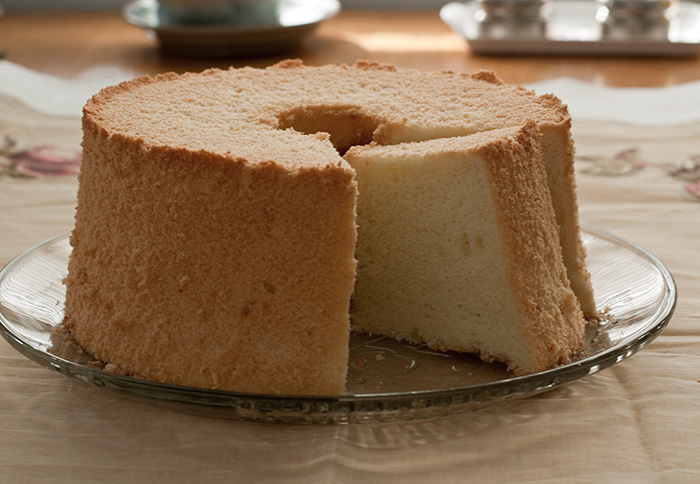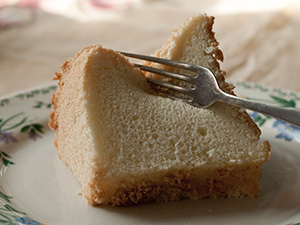
Chiffon Cake
| Ingredient | 10-inch Cake | 26cm Cake |
|---|---|---|
| Egg Yolk Mixture | ||
| cake flour | 5⅔ oz. | 160g |
| sugar | 5⅔ oz. | 160g |
| corn starch | ¾ oz. | 20g |
| egg yolk | 6 | 6 |
| vegetable oil | 4 Tbsp. | 80ml |
| water | ½ cup | 120ml |
| vanilla extract | 2 tsp. | 2 tsp. |
| Meringue | ||
| egg white | 8 | 8 |
| sugar | 2 oz. | 60g |
| salt | pinch | pinch |
This light-as-air chiffon cake is a relative of the classic angel food cake, but is far more tender and refined than the sponges sold in the supermarket. Delicious alone on a plate, you can also add a dollop of whipped cream or some fresh fruit to make an elegant-yet-simple dessert.

Preparation
- Separate the eggs; let the yolks come to room temperature but keep the whites in the refrigerator, preferably in the large bowl you will use to whip them, until just before using them.
- Preheat oven to 350°F (170°C).
Directions
- Prepare dry ingredients for egg yolk mixture.
Mix together the flour, corn starch, and sugar. Sift the mixture three to four times into a large mixing bowl. Stir lightly with a whisk, then make a well in the middle of the mixture. - Add liquid ingredients to the dry mixture.
In a small container mix the yolks, water, oil, and vanilla. Pour the liquid mixture into the hole in the middle of the dry ingredient mixture. Using a whisk begin stirring the liquid with a circular motion, gradually adding the dry ingredients by scraping a little off the sides of the well at a time, until all ingredients are well mixed. - Whip the meringue.
Add a pinch of salt to the chilled egg whites, then whip until foamy enough that it isn’t transparent. Continue whipping, adding one third of the sugar at a time, until the meringue is stiff enough that a peak will droop but hold its shape. - Fold the meringue into the egg yolk mixture.
Add one fourth of the meringue to the egg yolk mixture, stirring with a whisk until well mixed. Add half of the remaining meringue and stir gently with a circular motion into the top layer of egg yolk mixture until more or less mixed, then fold into the rest of the mixture with a gentle scrape-fold motion; mix thoroughly, but be careful not to deflate the meringue foam. Repeat with the other half of the meringue. Finally, use a spatula to scrape the bowl down and fold in to complete the mixing. - Bake.
Add the finished mixture carefully to a chiffon cake pan; pour all of it into one place in the pan, letting it flow around the chimney on its own. This reduces the likelihood of trapped bubbles. Use the spatula to smooth the top, then, holding the center section in place so it doesn’t leak, tap the bottom of the pan on a flat surface three or four times to bring any bubbles to the surface. Place the pan in the preheated 350°F (170°C) oven and bake for 50-60 minutes, or until a cake tester comes out clean. - Cool and remove from pan.
Place the cake pan upside down while it cools to prevent the cake from falling (if the pan doesn’t have feet around the edges, you can balance the center cone on something). Once it is cool, carefully slide a knife along the edges of the pan to loosen the cake, and remove it.
Notes
- If you don’t have anything useful to do with the two extra egg yolks and don’t want to waste them, you can get by with only 6 egg whites if you add 1½ tsp. baking powder to the dry ingredients at the beginning.
- When whipping the meringue you want to stop before it forms stiff peaks. If the meringue is too stiff, it will be difficult to mix it into the egg yolk mixture and the foam will break down while you’re mixing them together.
- Meringue tips:
- It’s important that the egg whites are well-chilled when you begin.
- Be sure the bowl you’re whipping it in is dry and very clean — any impurities can keep the eggs from properly forming a foam.
- Using the whisk to fold the mixture together instead of a spatula makes it easier to mix thoroughly without deflating the meringue.
